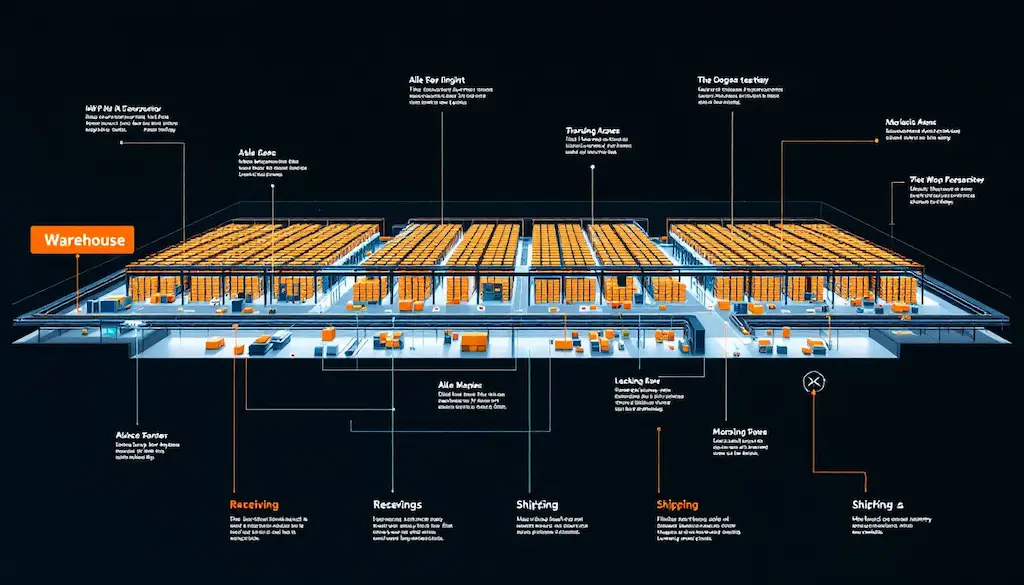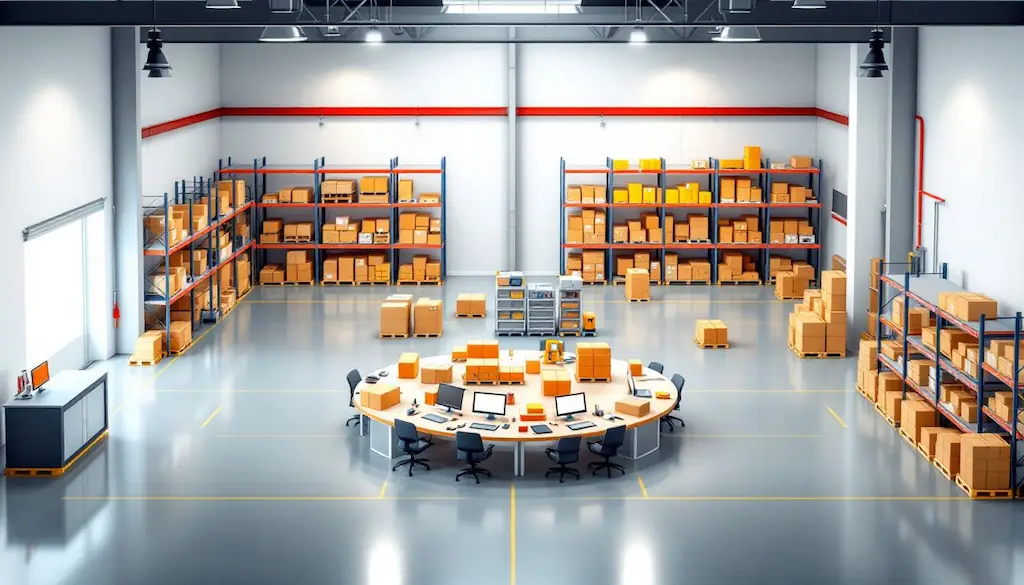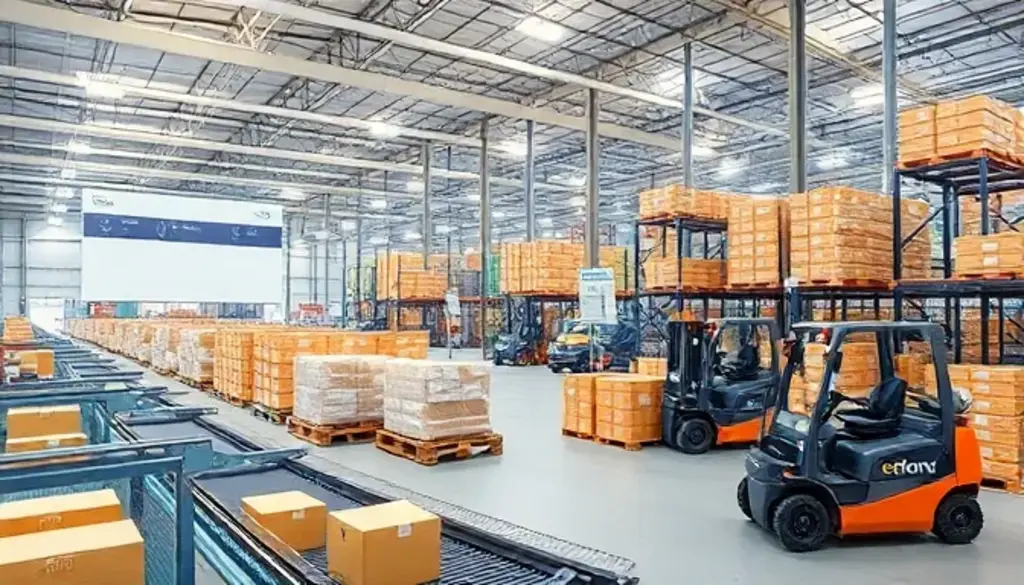
Warehouse organization is essential for maximizing efficiency and productivity. This article provides practical tips to transform your warehouse into a well-organized space. Discover strategies to reduce errors, improve safety, and streamline operations.
Key Takeaways
- Effective warehouse organization boosts operational efficiency, enhances safety, and minimizes mistakes, creating a productive environment.
- Utilizing optimized layouts, vertical storage, and automated solutions significantly improves space utilization and minimizes picking errors.
- Continuous training, regular maintenance, and clear labeling foster a safer workspace and streamline warehouse operations for sustained efficiency.
Importance of Warehouse Organization
Effective warehouse organization is the backbone of any efficient supply chain. When a warehouse is well-organized, warehouse inventory moves smoothly from one stage to another, reducing lead times and ensuring timely delivery to customers. Proper organization not only boosts operational efficiency but also enhances safety and inventory management, creating a more productive work environment.
Imagine the chaos of a cluttered warehouse: mistakes increase, work slows down, and fatigue sets in among warehouse employees. This disorganization leads to waste, including obsolete inventory and trash, which further reduces productivity. On the other hand, a well-organized warehouse allows for clear aisles and easy access to stored SKUs, minimizing accidents and injuries.
Maintaining organization isn’t a one-time task; it requires ongoing evaluation and improvement to adapt to business changes and ensure sustained efficiency. Warehouse managers must continuously assess and refine their organization strategies to stay ahead in the competitive market. Ultimately, proper warehouse organization is key to sustaining a successful business.
Optimizing Your Warehouse Layout
Planning a warehouse layout involves more than just placing shelves and racks. It’s about designing a flow that enhances efficiency from receiving to shipping. Key components of an efficient layout include designated areas for receiving, storage, packing, shipping, and employee facilities. This strategic design minimizes wasted time and boosts productivity.
Thinking both horizontally and vertically is crucial for maximizing warehouse space utilization. Regularly reviewing your warehouse space and product placement helps adapt to changing inventory needs, improving picking efficiency. Optimizing aisle space and utilizing vertical storage solutions can significantly enhance your warehouse’s operational efficiency.
A well-designed warehouse layout directly influences order picking efficiency, making it essential for warehouse managers to make strategic layout choices. Different products require varied storage methods, which should be considered in the overall layout design. This careful planning ensures smoother processes with minimal disruptions, ultimately leading to an efficient warehouse.
Effective Inventory Management Systems
Maintaining accurate inventory levels is crucial for a well-organized warehouse. An effective inventory management system helps achieve this by tracking inventory movement and allowing real-time updates. Warehouse Management Systems (WMS) are particularly beneficial, providing visibility into inventory levels and improving replenishment planning with warehouse management system software.
Continuous cycle counting is a valuable practice that enables regular verification of stock levels, enhancing inventory accuracy. Techniques like ABC analysis, which categorizes inventory based on value and movement, aid in optimal organization and easy access to vital stock. Additionally, Just-in-Time (JIT) practices help minimize holding costs and reduce inventory waste.
Implementing lean warehousing principles can streamline operations and eliminate unnecessary steps in inventory management. A robust WMS with features like intelligent cycle counts and real-time analytics supports these principles, ensuring accurate inventory counts and effective storage allocation. Monitoring inventory in real-time is critical for operational efficiency, providing the necessary data to optimize warehouse processes.
Utilizing Vertical Space
One of the most effective ways to maximize warehouse space is by utilizing vertical storage solutions. Vertical storage systems can save up to 90% of warehouse floor space, significantly increasing storage capacity and reducing picking errors. This approach allows for better space utilization without the need for additional floor area, keeping the warehouse organized and accessible.
Mezzanine platforms are an excellent solution for creating additional storage levels in warehouses with high ceilings. These platforms can be customized to fit the specific needs of your warehouse, providing extra storage space and improving overall efficiency. Automated storage solutions, such as vertical lift modules and vertical carousels, further optimize space and enhance retrieval efficiency.
Implementing vertical storage solutions reclaims valuable floor space and ensures efficient inventory storage. This not only maximizes your warehouse’s storage capacity but also streamlines the picking process, making it easier for employees to locate and retrieve items quickly.
Streamlining the Picking Process
The picking process is a critical aspect of warehouse operations, and optimizing it can significantly boost efficiency. An optimized layout and design are essential for efficient order picking and packing. Grouping similar types of products together in the warehouse contributes to better organization and faster picking.
Batch picking is a highly effective strategy that allows employees to collect items for multiple orders simultaneously, reducing travel time and increasing productivity. Additionally, picking popular SKUs together can enhance pick density and overall productivity. Creating pick lists that follow a logical pattern helps minimize unnecessary movement and streamline the picking process.
Using wearable or handheld scanning devices, such as barcode or QR code readers, can improve accuracy in the picking process. Ensuring that pickers have plenty of aisle room is also critical for safe and quick travel. Implementing these strategies can enhance productivity and reduce errors in the picking process, leading to a more efficient warehouse.
Improving the Receiving Process
An efficient receiving process is essential for maintaining accurate inventory records and ensuring smooth warehouse operations. Implementing a structured receiving checklist helps standardize operations and minimize errors. Utilizing modern warehouse management systems can significantly automate and streamline the receiving process, improving overall efficiency.
Tracking key metrics, such as dock-to-stock cycle time, is vital for assessing and improving receiving efficiency. Double-checking delivery documentation helps prevent errors in the inventory received, ensuring accurate records. Documenting any irregularities during the receiving process is essential for implementing future improvements and maintaining a high standard of accuracy.
Maintaining a clear and organized receiving area enhances safety and operational flow during busy periods. Efficient categorization of items upon arrival improves the speed and accuracy of subsequent warehouse processes. Focusing on these strategies ensures the receiving process runs smoothly and contributes to overall warehouse efficiency.
Implementing Automated Storage Solutions
Automated storage solutions can revolutionize your warehouse operations by significantly reducing labor costs and minimizing inventory errors. These systems provide secure access and tracking, improving inventory control and reducing loss and damage. Automated systems can increase picking accuracy to nearly 99.9%, thanks to integrated technology that minimizes human errors.
Automated storage solutions enhance layout efficiency by optimizing storage and streamlining processes. They can double picking throughput by eliminating the time spent walking and searching for items, delivering items directly to workers. This not only improves efficiency but also reduces labor costs and increases overall productivity.
Additionally, Automated Storage and Retrieval Systems (ASRS) can reclaim valuable floor space by storing items overhead, maximizing storage within a compact area. ASRS delivers items at optimal ergonomic heights, reducing the risk of worker injury and fatigue. Implementing these automated solutions creates a more efficient and organized warehouse environment.
Maintaining Clean and Safe Workspaces
A clean warehouse promotes a positive impression and is vital for enhancing efficiency, safety, and productivity. Regular cleaning and organization are crucial for maintaining order and preventing accidents. Identifying areas with high traffic and risk allows for focused cleaning efforts, ensuring that these areas remain safe and accessible.
Cleaning schedules should be tailored to align with operational hours to avoid workflow disruptions. Deep cleaning sessions are important for maintaining areas not covered by regular cleaning routines, ensuring that the entire warehouse remains clean and organized. Engaging employees in cleanliness initiatives fosters a shared responsibility for maintaining a safe work environment.
Proper use of personal protective equipment (PPE) is crucial for the safety of cleaning staff. Dust control on high surfaces is essential to protect both employee health and inventory quality. Regular inspections of aisles and exits are crucial for preventing accidents and maintaining access. A structured waste management system supports cleanliness and compliance with environmental regulations.
Regular Maintenance and Training
Regular maintenance is essential for the optimal performance and safety of equipment and systems. Conducting consistent inspections helps identify issues early before they escalate, ensuring that equipment remains in good working condition. Developing a comprehensive training program for staff supports awareness of maintenance and safety protocols, empowering employees to detect potential problems.
Training employees on maintenance practices enhances safety and ensures that they understand the importance of regular maintenance. Periodic warehouse inspections should include identifying maintenance opportunities for equipment and other physical aspects. Evaluating tidiness and proper maintenance of warehouse space regularly is crucial for sustaining an efficient work environment.
Shelves may need repairing, and lights may need replacing as part of regular maintenance. Utilizing data from maintenance systems can optimize schedules and improve procedures based on actual equipment performance. Regular maintenance and training ensure a safe and efficient warehouse environment.
Using Labels and Signage Effectively
Clear labeling serves as a visual guide for item location, contents, and ownership within the warehouse, improving overall efficiency. Using bright colors and clear fonts on labels aids in quick identification and reduces search time. Implementing a barcode system enables efficient tracking of inventory with minimal errors, enhancing inventory accuracy and mitigating losses due to misplacement.
Effective label placement improves visibility, making it easier for staff to locate items quickly. Labels should be made from durable materials to withstand regular handling and environmental conditions, ensuring they remain readable and effective for warehouse operations. Regular maintenance of labels ensures they continue to serve their purpose and support warehouse efficiency.
Utilizing a systematic labeling framework can streamline operations and enhance overall warehouse efficiency. Signage helps ensure employee safety and guides navigation, indicating pathways and hazard zones. Effective use of labels and signage creates a more organized and efficient warehouse environment.
Summary
In summary, maintaining an organized warehouse is crucial for maximizing efficiency, safety, and productivity. By optimizing your warehouse layout, implementing effective inventory management systems, utilizing vertical space, streamlining the picking and receiving processes, and maintaining clean and safe workspaces, you can ensure a well-organized warehouse. Regular maintenance, employee training, and effective use of labels and signage further enhance warehouse operations. Continuous improvement and adaptation to changes are key to sustaining success in the competitive market.
Ready to Take Your Warehouse Efficiency to the Next Level?
Discover how Logimax’s Warehouse Management System can turn these organization tips into long-term operational success. From real-time inventory tracking to optimized layouts and automated workflows, our scalable solutions are built to streamline your operations and boost productivity.
Schedule a free demo today and see how Logimax can transform your warehouse.
Frequently Asked Questions
What are the 3 warehouse layout options?
The three warehouse layout options are U-shaped, I-shaped, and L-shaped, each designed to enhance efficiency based on your specific workflow needs. Choose the one that best fits your space and business operations to maximize productivity!
How is a warehouse organized?
A well-organized warehouse enhances efficiency by creating a clear floor plan, applying the 80-20 rule, and strategically labeling items according to their usage frequency. By implementing these steps, you’ll streamline operations and improve productivity!
Why is warehouse organization important?
Warehouse organization is crucial because it boosts operational efficiency, enhances safety, and streamlines inventory management, ultimately leading to fewer mistakes and increased productivity. Embrace organization to transform your warehouse into a thriving hub of success!
How can I optimize my warehouse layout?
To optimize your warehouse layout, focus on the flow of goods from receiving to shipping while utilizing both horizontal and vertical space effectively. Regularly reviewing your space and product placement will keep operations efficient and responsive to needs.
What are the benefits of using a Warehouse Management System (WMS)?
Using a Warehouse Management System (WMS) significantly boosts your operational efficiency by providing real-time visibility into inventory levels and enhancing replenishment planning. Embrace this technology to streamline your processes and elevate your warehouse performance!






